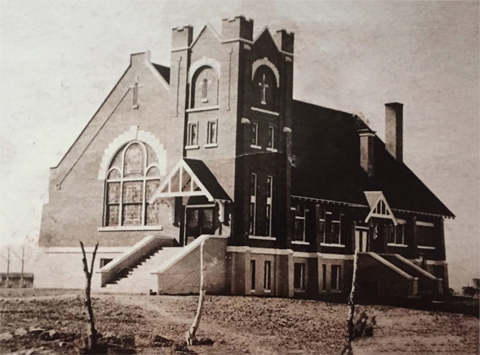(by Mary Bush)
David Bowen, a convert to the LDS Church, was born June 18, 1837 at Blaenavon, S. Wales. He was sent to America by his father with the purpose in mind of making money to send back to his parents, brothers and sisters so they too could come to America.
David was the oldest son of Lewis Bowen and Mary Ann Harris. Before he came to Salt Lake City he endured many hardships and deprivations for the Gospel of Jesus Christ of Latter Day Saints. He left his home in South Wales when about 19 years of age. Early in the year 1856, he bid farewell to home and friends. When he arrived at the seaport he boarded a sailing vessel. When nearing the American shore the vessel was driven back about 300 miles by wind which was very disappointing to the already weary emigrants who were in high hopes of soon landing. From New York to Rock Island, Ill. the journey was uneventful. At Rock Island the company was fitted out with hand carts. Two men and two women made a team. Each person was allowed seven lbs. Free luggage. The balance of the load was made up of provisions, cooking utensils and bedding. In this way he crossed the plains, a distance of 1300 miles.
The journey was tedious. The company started early in the season so arrived in Salt Lake City early in the autumn before bad weather began. In 1857 Johnson’s army came to Utah intending to exterminate the Mormons so David Bowen was called to serve in the Echo Canyon War to prevent the said army from entering Utah Territory. He wasn’t sufficiently clothed to keep warm for it was in the fall and winter that year the Utah boys had to be on the job.
When he was married he also had obtained a wagon and a yoke of oxen.
In the fall of 1860 he met Annie Shackleton and they were married the following year, Feb. 16, 1861. He owned a five acre lot in what was call the “big field” but after marriage he bought half a city lot with a small adobe house on it. In 1862 David’s brother, John, came to Utah so the two of them hauled wood to Camp Douglas and made enough money for the rest of the family to emigrate from England in the year 1863.
Many times he didn’t know where he was going to get money or work with which to take care of his family. But being a very industrious man he always seemed to be able to provide the meager things for his family. They lived in Salt Lake City for eight years during which time four children were born. In 1858 David Bowen contracted typhoid fever and lay near death for many weeks. In 1869 they left Salt Lake City to try life on a farm. Accordingly, in the fall, they moved to Idaho and settled at a place called Henderson Creek. Here they lived for about seven years during which time three more sons were born. They had to fight crickets to save their crops. As there was no school for their children, the parents taught them as they before had been taught by their parents All the clothes for the entire family were made by hand until the ninth child was nine years old when a sewing machine was bought.
In 1876 they again sold their home, moving to Samaria which was their home for 24 years. At the time they moved there, there were no ward organizations. They were a branch of the Malad ward but there was a school which they attended. The seventh child was the first that had the privilege of entering school at the proper age. David Bowen understood music as did his father before him so he was asked to organize and lead a choir. This he did, but as the only music they had was his, he and his wife spent hours copying music so they would have some for others. About his time they organized a Mutual Improvement Association and David Bowen was chosen president of the young men while his wife was assigned to the young ladies. Again they didn’t have material or books enough to go around so had to write much of the things they used.
During the time David Bowen lived in Samaria he aquired two farms by hard work and with the help of the older sons. In the year 1900 David and his family moved to Logan, Utah where he resided until he died, March 31, 1910. After moving to Logan several of the grandchildren were given a home while they received their education.
